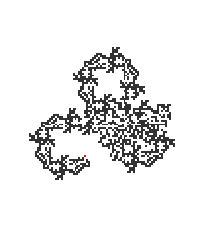Turmite

First off, a turmite is not an insect like a termite, even though their names sound similar. A turmite is actually a kind of computer program that is used to simulate how simple patterns can change and evolve over time.
Imagine you have a bunch of white tiles on a black background, and there's a little "bug" sitting on one of those tiles. This bug is called a turmite. The turmite has only a few basic rules that it follows:
- If the tile it's currently on is white, it changes that tile to black, turns to the right, and moves forward one tile.
- If the tile it's currently on is black, it changes that tile to white, turns to the left, and moves forward one tile.
That's it! Those are the only things a turmite knows how to do. But when you set a turmite loose on a field of tiles and watch it go, something magical happens. Over time, the patterns that the turmite creates can become incredibly complex and beautiful.
For example, if you start a turmite on a completely white field and let it run for a while, it might create an intricate, swirling pattern that looks like a big snail shell.
What's really fascinating about turmites is that even though they follow such simple rules, they can still create incredibly complex patterns. Scientists and mathematicians like to use turmites to study things like emergent behavior (when lots of simple things working together create something very complicated) and cellular automata (a way of simulating how lots of individual cells interact to form larger structures).
So, in summary: a turmite is a simple computer program that simulates a bug moving around and changing the colors of tiles on a grid. Even though a turmite only knows a few basic rules, it can create really complex and beautiful patterns over time. It's like watching a little bug make a pretty picture!
Imagine you have a bunch of white tiles on a black background, and there's a little "bug" sitting on one of those tiles. This bug is called a turmite. The turmite has only a few basic rules that it follows:
- If the tile it's currently on is white, it changes that tile to black, turns to the right, and moves forward one tile.
- If the tile it's currently on is black, it changes that tile to white, turns to the left, and moves forward one tile.
That's it! Those are the only things a turmite knows how to do. But when you set a turmite loose on a field of tiles and watch it go, something magical happens. Over time, the patterns that the turmite creates can become incredibly complex and beautiful.
For example, if you start a turmite on a completely white field and let it run for a while, it might create an intricate, swirling pattern that looks like a big snail shell.
What's really fascinating about turmites is that even though they follow such simple rules, they can still create incredibly complex patterns. Scientists and mathematicians like to use turmites to study things like emergent behavior (when lots of simple things working together create something very complicated) and cellular automata (a way of simulating how lots of individual cells interact to form larger structures).
So, in summary: a turmite is a simple computer program that simulates a bug moving around and changing the colors of tiles on a grid. Even though a turmite only knows a few basic rules, it can create really complex and beautiful patterns over time. It's like watching a little bug make a pretty picture!
Related topics others have asked about:
